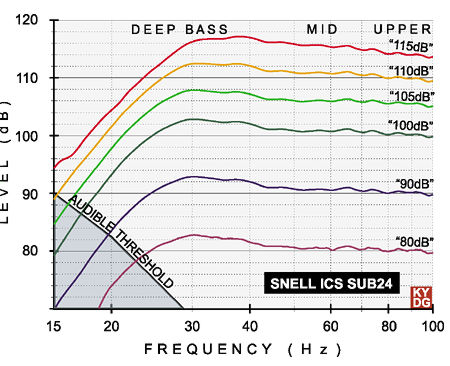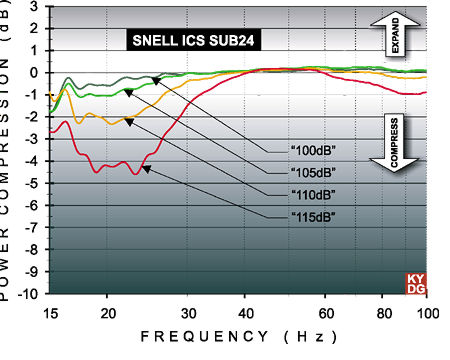Way Down Deep III Snell ICS Sub24
Snell Acoustics has a history of attracting top-drawer engineering talent. Joseph D'Appolito, current chief of engineering at Snell, is a familiar name to many readers. The vertical array of midrange-tweeter-midrange seen in many modern speaker designs is called a "D'Appolito" configuration, and many speaker builders and reviewers are on their second or third copy of his book, Testing Loudspeakers, an activity for which they may use microphones of his design. Snell's ICS Sub24 comes painted an all-business black. Its front baffle houses a pair of front-firing 12-inch drivers, two ports, and a level control. The electronics module is in the rear.
Measurements
Frequency response at 80dB (Fig.6): 20–100Hz, +/-4.0dB; –11dB at 18Hz. There was a very slight (roughly 2dB) hump centered at 30Hz, below which the response tapered off slowly, then increased to approximately 24dB/octave at roughly 25Hz.

Fig.6: Frequency Response vs. Output
Frequency response at higher levels (Fig.6): Some progressive softening below 30Hz; otherwise, the response shape remained intact at higher levels.
Dynamic range: Low power compression (Fig.7) and strong performance on the Linkwitz shaped tone-burst tests (Fig.8); the ICS Sub24 is capable of unusually high peak output levels for its price range.

Fig.7: Power Compression

Fig.8: Shaped Tone-burst Peak Output
Total harmonic distortion (Fig.9): Generally low, but increasing notably at 105B and above, at and below 25Hz.

Fig.9: Total Harmonic Distortion vs. Frequency & Level
Listening
It was a bright summer afternoon. I had on an old pair of Dockers shorts and a fresh T-shirt. I cued up the test track, sat down in my "money seat"—a folding lawn chair—and a few moments later, I could have sworn I saw out of the corner of my left eye a white bird zoom by so close that its feathers brushed my leg. I was startled but shrugged it off, and I replayed the ending of "Jurassic Lunch," the part where the dinosaur clomps on the ground at 1:02. Same sensation of feathers brushing my leg. It turned out to be no Hitchcockian avian attack, but jets of air from the Snell ICS Sub24's ports some eight feet away, pulsing against my bare legs and accompanied by a faint fluttering sound.
 The incident illustrated how an especially vivid report in one or several sensory domains can trick the mind into manufacturing a report in another domain. There's the textbook case of how the vividly recorded sound of a match being struck can trigger the sensation of burning sulfur. In this case, it was something that felt like a feather brushing against my leg outdoors, accompanied by something that sounded vaguely like a bird beating its wings, which triggered the fleeting visual sensation of a bird veering off course and grazing my skin.
The incident illustrated how an especially vivid report in one or several sensory domains can trick the mind into manufacturing a report in another domain. There's the textbook case of how the vividly recorded sound of a match being struck can trigger the sensation of burning sulfur. In this case, it was something that felt like a feather brushing against my leg outdoors, accompanied by something that sounded vaguely like a bird beating its wings, which triggered the fleeting visual sensation of a bird veering off course and grazing my skin.
The incident illustrated something else as well: At the lowest frequencies in ported designs, it's the port that does the work at and below its resonant frequency. Below 25Hz, down where the dino disturbance dwells, and dialed up to the level a real dino would make, enough air squirts through the Snell's ports to blow out a match 6 or 8 feet away.
My session notes of the U-571 depth-charge passage (Fig.B3) cite the physicality of the explosions bringing a lifelike sense of near-terror to match the visual report of men and submarine being racked and battered. The sound was big and unstrained, as if playing it were no more taxing than playing "Bridge Over Troubled Water." When I left the volume setting on the Lexicon MC12B pre-pro unchanged (producing sub-only peaks of 111dB) and reconnected the main speakers, all the pieces came together to make a compelling, you-are-there experience.
With the main speakers still connected, the Pearl Harbor selection gave similar satisfaction (Fig.D3): Bass quality was solid, clean, effortless, free of the tendency for mud to fill in the tiny quiet spaces between gun discharges. When I disconnected the mains and listened again, the ports could be heard making chuffing noises, but those artifacts sank into inaudibility—masked—once I reconnected the mains.
The Snell Sub24 couldn't hang with the far more expensive Genelec or ServoDrive in dishing up the 18Hz gut-rumble that relays the sense of doom in Black Hawk Down's "F'ing Irene" scene (Fig.C3). The vast majority of subs missed that near-infrasonic roar as well, yet there was something about the Snell—I suspect it comes from a refreshing freedom from power compression above roughly 30Hz—that made the passage work every time I tried it.
The four bass-drum strokes in track 5, "March of the Exorcists," from the Casper CD sounded deep, appropriately resonant, and effortlessly natural. There was no fuzz, no chuffing, nothing to detract from the appeal of a well-played, well-recorded drum stroke.
In absolute terms, the Sub24 didn't create the most gripping performance on the Blue Crush passage, but it clearly came across as a much bigger, more expensive sub than it is. The surfer girl comes up, gasping for air, while a seething, massive wall of water bears down, about to pulverize her. With only a handful of subs, including the Snell, you get swept away by the scene every time.
The Sub24 got The Matrix chopper-crash scene starting at 1:51:03 close to perfect. The pod-racer explosion in the tunnel at about 1:01:40 into Star Wars Episode I: The Phantom Menace sounded clean up to 112dB, a playback level that tied in realistically with the visuals. But at that level, the sub was out of headroom: Whether I drove it 1dB or 5dB harder, it produced less than half a decibel more output. For those with especially large and/or comprehensively treated rooms and a penchant for cranking it up to levels uncomfortable for most of the audience, a second or even third unit may be indicated. (Snell's literature states that the Sub24 will produce up to 110dB continuously in a room of 3000 cubic feet.)
The Bottome Line
I was initially afraid that the air-blast-against-the-legs experience could subjectively stack the deck against the Snell. I needn't have worried. Port noise was never audible when the main speakers were connected, and only barely audible when the sub was playing solo, and then only at the highest playback levels. That aside, the Sub24 is a notably strong, well-balanced package. Not the performance champ in any one category, it places near the top in each. That it's a fraction of the price of the few subs that outpoint it ensures its bargain status.
Specifications
Snell Acoustics ICS Sub24 powered subwoofer in reflex (ported) enclosure of 1"-thick MDF
Drivers: two 12" custom cones in diecast frames
Frequency response: 23–200Hz, +/-3dB; –6dB @ 20Hz
Inputs: line-level (RCA) and speaker level (5-way binding posts)
Outputs: highpass (RCA)
Amplifier: 450W RMS
Highpass filter: 80Hz, 12dB/octave
Lowpass filter: Adjustable, 50–150Hz, 12dB/octave
Phase: 0°/180°
Other: certified THX Ultra 2; front-mounted level control
Finishes: black texture paint; other finishes available at extra charge
Dimensions: 29" x 17.5" x 22.25" (WxHxD)
Weight: 115 lbs
Price: $2600
Snell Acoustics
(978) 538-6262
www.snellacoustics.com
- Log in or register to post comments






























































